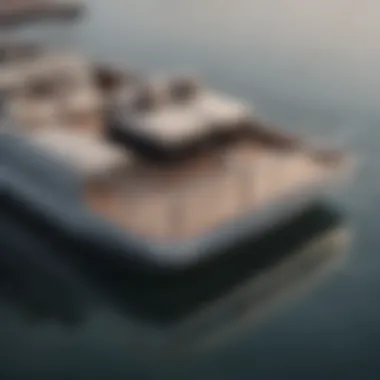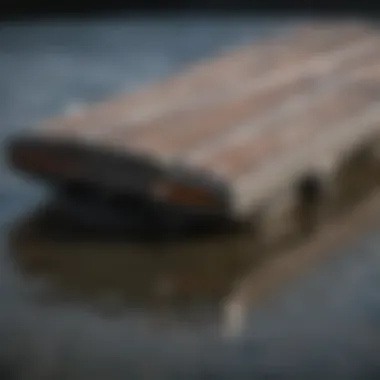The Anatomy of Pontoon Top Decks: A Comprehensive Overview


Intro
Pontoon top decks are an essential component of pontoon boats, often serving as the primary area for socializing, relaxation, and enjoying time on the water. Understanding the intricacies of these structures is vital for both existing and prospective pontoon owners. This article examines the design, functionality, materials, and maintenance aspects that define pontoon top decks. By exploring the available types and their respective benefits and limitations, we aim to guide boating enthusiasts in making informed decisions regarding their pontoon ownership and modifications.
As we dissect the anatomy of pontoon top decks, we will delve into performance metrics, such as fuel efficiency and handling. We will also touch upon the nuances involved in selecting and maintaining pontoon top decks. Throughout the content, anecdotal user experiences and expert opinions will be integrated to provide a comprehensive overview that transcends mere technical specifications. Our discussion will enable readers to grasp not only what makes an effective pontoon top deck but also how to tailor one to fit their unique needs and preferences.
Understanding Pontoon Top Decks
Pontoon top decks are a central aspect of pontoon boat design and functionality. Understanding them is crucial for both new and seasoned boating enthusiasts. The top deck provides not only aesthetic appeal but also practical benefits for usage, safety, and adaptability during various water activities.
The significance lies in the balance between design and function. With a diverse range of activities, from leisurely cruising to thrilling water sports, the top deck must support these needs while ensuring comfort and safety for all passengers. Moreover, the materials and components used can heavily influence the deck's overall durability and maintenance needs.
In this section, we will explore the fundamental elements of pontoon top decks. We will discuss the essential features that make them effective and attractive while detailing how they can enhance user experience on the water.
Preface to Pontoon Design
Pontoon design has evolved significantly over the years, emphasizing both appearance and functionality. The structure generally consists of two or more floats or tubes, providing stability in water. However, the top deck adds a new dimension, expanding the potential uses of the boat.
Boat manufacturers have tailored pontoon designs to cater to specific scenarios, such as family outings or fishing trips. As such, it becomes essential to consider how the deck can work to serve these purposes efficiently. The design impacts everything, from the layout and arrangement of seating to optional additions like sun shades or cooking stations. Accordingly, understanding these aspects ensures that one selects a pontoon that meets their unique needs.
Key Components of a Pontoon Top Deck
The key components that make up a pontoon top deck are various and together create an integrated platform. Each part serves a distinct purpose and contributes to the overall utility of the boat.
- Deck Surface: Materials like marine-grade plywood, aluminum, or composite materials define the durability and safety. A non-slip surface is typically preferred for wet conditions.
- Seating Arrangements: Comfortable seating is paramount. Different configurations are available, including lounge areas, captain's chairs, or benches.
- Storage Solutions: Integrated storage compartments keep essential items secure and organized, enhancing ease of access while on the water.
- Safety Elements: Railings, non-slip surfaces, and safety handholds are crucial for preventing accidents and ensuring passenger security.
These components affect everything from safety to comfort, making it imperative to understand their roles in pontoon top deck design.
Materials Used in Pontoon Top Decks
Understanding the materials utilized in pontoon top decks is vital for any enthusiast or potential buyer. The choice of material affects durability, maintenance, performance, and aesthetics. Each material brings distinct advantages and considerations, influencing the overall experience on the water.
Wooden Top Decks
Wood has long been a favorite for pontoon top decks due to its classic look and feel. The aesthetic appeal of natural wood is unmatched, offering a warm and inviting atmosphere. However, it is not without risks. Wood is susceptible to rot and decay, especially in a humid or wet environment. Regular maintenance is crucial to prolong its life, including applying sealants and performing re-staining.
Another aspect of wooden decks is their weight. While wooden constructions can offer a sturdy feel, they also increase the overall weight of the pontoon. This can affect fuel efficiency and handling. Additionally, installing wooden decks typically requires more labor, and the cost can be significant depending on the type of wood chosen.
"Investing in high-quality marine-grade materials can significantly enhance the longevity of your pontoon deck."
Aluminum Top Decks
Aluminum has gained popularity for pontoon top decks, mainly due to its lightweight properties and corrosion resistance. The benefits of going with aluminum include lower maintenance needs and prolonged lifespan. Unlike wood, aluminum does not warp or rot, making it a more reliable choice for various weather conditions.
Despite its advantages, aluminum can be prone to dents or scratches. Care during use is advised to avoid damaging the surface. In terms of installations, aluminum decks can be easier to work with. Builders often find that the weight savings allow for more options in pontoon design and performance enhancements. Aluminum’s versatility also opens a range of finish options, from bright polished surfaces to powder coating, providing varying aesthetic choices.
Composite Materials
Composite materials represent a blend of toughness and innovative technology in pontoon construction. These materials typically combine plastics with reinforcement fibers. The resulting structure offers high durability while being resistant to moisture and UV rays. One of the significant advantages of composites is their lightweight nature, comparable to aluminum, but often providing better resilience against impacts.
Composites can also mimic the finish of wood without the associated maintenance needs. This aspect makes it an attractive choice for many, particularly those focused on long-term usability and minimal upkeep. The range of colors and textures available allows for considerable customization as well. However, the cost of composite materials can sometimes be higher than traditional options, which could be a significant factor for budget-conscious buyers.
In summary, the materials used for pontoon top decks fundamentally shape the boating experience, affecting functionality, aesthetics, and maintenance. The decision between wooden, aluminum, or composite options is crucial and should be considered carefully based on individual preferences and usage patterns.
Design Considerations
Design considerations play a critical role in the functionality and usability of pontoon top decks. It is not merely about how a deck looks; it encompasses layout, safety features, and aesthetic choices that contribute to the overall experience on the water. Each of these elements interacts to enhance how users engage with their pontoon boats, making thoughtful design essential for both practical use and enjoyment. A well-designed top deck promotes easy access, encourages various recreational activities, and ensures that safety is never compromised.
Layout Options


Layout options are foundational to the functionality of pontoon top decks. When planning a layout, one must consider seating arrangements, social interaction areas, and space for storage. A common layout includes an open space in the middle for movement, surrounded by comfortable seating. This encourages socialization and maximizes the deck's usability.
In integrating various layout styles, it’s important to think about the anticipated activities on the pontoon. If fishing is a primary use, then more open space might be advisable. Conversely, if passenger comfort is prioritized, a layout featuring built-in lounges or recliners may be better suited.
Potential layouts include:
- U-Shaped Seating: Promotes conversation and creates an inviting environment.
- Lounge Section: Provides a place for relaxation, catering to sunbathers.
- Dual-Zone Design: Offers areas for both active and passive use, enhancing versatility.
- Creative Storage Solutions: Integrating storage within seating not only preserves space but also improves overall functionality.
Each design choice can substantially impact the enjoyment and utility of the pontoon.
Safety Features
Safety features are paramount when designing a pontoon top deck. Properly engineered decks include elements that aren’t visible or obvious but have a significant role in safety. Non-slip surfaces are a must to restrict accidents, especially when the deck is wet. Railings, ideally extending at least two feet above the deck, provide an essential boundary to prevent falls.
Furthermore, incorporating secure storage for safety equipment like life jackets and fire extinguishers can increase accessibility in emergencies. It's also wise to have a designated first aid kit nearby, ideally in a waterproof container. Safety considerations can include:
- Adequate Railings: To prevent accidental falls.
- Non-Slip Textures: To minimize slips, especially in wet conditions.
- Lighting: Adequate lighting for night navigation or use.
By prioritizing these safety features, pontoon owners can ensure a more secure and enjoyable experience on the water.
Aesthetic Aspects
Aesthetic aspects of pontoon top decks are often the first elements noticed by observers. Color and design choices must be harmonious with the surrounds, enhancing generally perceived value. Selecting materials that visually complement the water or landscape can create a means to set the boat apart.
Moreover, including custom features such as decorative railings or patterned upholstery offers personal touch to the pontoon boat, making it unique. Popular trends in aesthetics include:
- Natural Wood Finishes: Lending a classic touch.
- Vibrant Fabrics: Adding a lively element.
- Integrated Lighting: For evening activities and ambiance.
Ultimately, while aesthetics might initially appear superficial, they tie directly into the experience and comfort on the pontoon. A well-thought-out design that emphasizes both style and functionality can truly elevate the time spent on the water.
Functional Benefits of Pontoon Top Decks
Pontoon top decks offer several functional benefits that enhance the user experience on the water. Understanding these benefits can inform users on how to effectively utilize their boats. The functionality of these decks is critical not only for comfort but also for practicality during recreational activities. Each benefit contributes to creating a well-rounded boating experience.
Enhanced Seating Capacity
One of the distinctive features of pontoon top decks is their ability to accommodate more seating. Many designs integrate modular options that let boat owners personalize the layout according to their preferences. The increased seating capacity is advantageous for social activities, allowing friends and family to gather comfortably while enjoying leisure time on the water.
When considering enhanced seating, it is essential to select durable materials. Cushions should be waterproof and resistant to fading. This ensures they hold up well against sunlight and moisture. Many owners opt for Lounge seating, which provides ample room for relaxation. Additionally, the arrangement of seating not only impacts comfort but also safety. A well-planned seating layout can prevent overcrowding and enable easy movement around the deck.
Increased Storage Solutions
Another significant benefit of pontoon top decks is the provision of ample storage options. With various compartments and storage solutions, boaters can safely stow away gear and equipment. This aspect is especially useful for enthusiasts who engage in different water activities like fishing, swimming, or water sports.
Key storage solutions to consider include:
- Under-seat storage: Creates space for personal belongings while maintaining a clean deck.
- Built-in lockers: Handy for storing larger items such as life jackets, fishing rods, or extra fuel.
- Cup holders with storage: Allows for convenience without cluttering the deck.
These elements not only contribute to accessibility but also enhance the aesthetic appeal of the pontoon. A tidy and organized deck can significantly improve the overall sailing experience.
Versatility for Recreational Activities
Pontoon top decks are designed for versatility. They can be adapted to cater to various recreational activities, making them a favorite among boating enthusiasts. Whether it is fishing, sunbathing, or hosting gatherings, these decks are engineered to facilitate a range of experiences.
Many pontoon decks can accommodate additional features that enhance their versatility:
- Swim platforms: These make it easy to access the water for swimming or diving.
- Fish cleaning stations: A practical addition for anglers wanting to process their catch on-site.
- Integrated sound systems: Enhances the enjoyment during social events out on the water.
The ability to customize and modify pontoon top decks allows boaters to tailor their crafting to suit specific recreational needs. By considering which activities will be most frequent, boat owners can optimize the use of their deck space.
"Pontoon top decks are not just platforms; they are central to creating memorable aquatic experiences."


In summary, the functional benefits of pontoon top decks extend beyond mere aesthetics. Enhanced seating capacity, increased storage solutions, and versatile designs significantly improve the overall boating experience. These factors play a crucial role in ensuring satisfaction for pontoon owners and their guests.
Market Trends in Pontoon Top Decks
Understanding market trends in pontoon top decks is crucial for both manufacturers and consumers. The evolving preferences in design, materials, and functionality directly affect purchasing decisions and product development. Keeping an eye on these trends helps consumers make informed choices and manufacturers to stay competitive.
Current Innovations
Innovations in pontoon top decks often focus on enhancing performance and user experience. For example, the incorporation of advanced lightweight materials improves buoyancy and handling. Innovations also include integrated solar panels, making these boats more eco-friendly by utilizing renewable energy. Technologies for smart monitoring are emerging, enabling users to track various metrics like weight distribution and fuel consumption. These developments cater to a tech-savvy audience that values efficiency and innovation.
Eco-friendly Materials
Today, many buyers are leaning towards eco-friendly materials for their pontoon top decks. Manufacturers are using recycled composites and sustainable wood options to fulfill this demand. This not only appeals to environmentally conscious consumers but also helps brands differentiate themselves in a crowded market. Adopting such materials shows commitment to sustainability and can enhance brand loyalty.
Consumer Preferences and Feedback
Consumer preferences have changed significantly over the years. Many buyers now prioritize functionality alongside aesthetics. For instance, modular designs that allow for easy customization are increasingly popular. Feedback from boating enthusiasts often highlights the need for versatile seating arrangements and practical storage solutions. Tapping into these preferences is essential for manufacturers aiming to fulfill modern consumers' expectations. Reviews and discussions on platforms like Reddit provide valuable insights into what users desire, allowing manufacturers to adapt accordingly.
Embracing market trends can lead to greater customer satisfaction and brand recognition. Staying updated with consumer feedback is vital for developing products that resonate with users.
Customization Options for Pontoon Top Decks
Customization options play a critical role in enhancing the usability and aesthetics of pontoon top decks. As consumers increasingly seek to personalize their boats to match their lifestyle and preferences, understanding the various customization elements becomes paramount. Customization not only allows for personal expression but also boosts functionality. Tailoring aspects such as fabric choices, color selection, and added accessories can significantly transform a standard pontoon into a unique space suitable for leisure and entertainment.
Fabric Choices
Selecting the right fabric is essential for pontoon top decks. The fabric choices influence the durability, comfort, and overall look of the deck. Common materials used include vinyl and marine-grade canvas. Vinyl is popular for its durability and ease of cleaning. It resists moisture and can withstand harsh sunlight, making it a practical choice for boaters in hot climates. Marine-grade canvas, on the other hand, offers breathability and a classic aesthetic. It may require more maintenance but provides a soft feel and a range of textures.
When choosing fabrics, consider the following:
- Weather Resistance: Look for fabrics treated for UV protection and water resistance.
- Maintenance Requirements: Some fabrics are easier to clean than others.
- Comfort: Textiles should provide a comfortable seating experience for long durations.
Color and Finish Selection
Color and finish selection adds another layer of personalization to a pontoon top deck. The right colors can evoke specific moods and enhance visual appeal. Lighter colors can create a spacious feel, while darker shades may offer a striking contrast.
Finish options also matter. Matte finishes can provide a sophisticated look, while gloss can enhance color vibrancy and ease of cleaning.
It is advisable to choose colors and finishes based on:
- Aesthetic Preference: Select colors that resonate with personal style.
- Resale Value: Neutral colors often appeal to a broader audience.
- Heat Absorption: Darker colors may absorb more heat, making the deck less comfortable on sunny days.
Adding Accessories
Accessories are important for maximizing the functionality of pontoon top decks. They can enhance convenience and transform the ambiance. Common accessories include storage solutions, lighting, and railings.
Each accessory should be considered carefully. For example:
- Storage Solutions: Storage benches or under-deck compartments help keep the area tidy.
- Lighting Options: LED lighting can add both functionality and atmosphere, especially for evening outings.
- Safety Rails: Adding rails boosts the safety of the space, particularly for families.
"Customization not only elevates the aesthetic appeal but also serves practical applications, aligning the pontoon deck with user preferences."
Maintenance of Pontoon Top Decks
Maintaining pontoon top decks is crucial for various reasons, including safety, durability, and aesthetics. Regular maintenance not only extends the lifespan of the deck but also enhances the overall boating experience. A well-maintained pontoon deck provides a stable surface for activities and protects it from environmental wear. Additionally, the appearance of the deck can influence the resale value of the pontoon. Thus, understanding how to properly maintain a pontoon top deck is essential for any boat owner.
Cleaning and Care Routines
Cleaning is a fundamental aspect of pontoon deck maintenance. Accumulated dirt, grime, and mildew can damage the materials and lead to safety hazards. It is advisable to wash the deck regularly with a mild soap and water solution. Using a soft-bristle brush can help remove stubborn stains without scratching the surface. In certain cases, specialized cleaners designed for marine surfaces may be necessary.
After cleaning, it is important to rinse everything thoroughly to eliminate any residue.
Some best practices include:


- Regular Cleaning: Aim for cleaning after every use, particularly if exposed to saltwater.
- Spot Treatment: Address stains promptly to prevent them from setting.
- Drying: Allow the deck to dry completely to avoid mold and mildew growth.
Repairs and Upkeep
Regular inspections for wear and tear on pontoon top decks are vital. Identifying issues early can prevent more significant problems down the line. Common areas of concern include scratches, fading, and loose components. For minor scratches, a simple touch-up paint may suffice, while deeper gouges might require patching.
More significant repairs might involve replacing sections of the deck or reinforcing structures if they show signs of weakness.
Owner recommendations for upkeep include:
- Quarterly Inspections: Look for signs of damage such as loose screws or nails that need tightening.
- Professional Help: For major repairs, consult professionals who specialize in marine maintenance to ensure repairs are done correctly.
Long-term Preservation
Long-term preservation of pontoon top decks involves proactive strategies to mitigate the effects of weather and use. Applying UV protective coatings can shield the material from sun damage. Furthermore, storing the pontoon indoors during off-seasons helps avoid exposure to harsh elements, which can drastically reduce the lifespan of the deck.
Considerations for effective preservation include:
- Seasonal Maintenance: Prepare the deck before and after each season, focusing on deep cleaning and protective coatings.
- Storage Solutions: Utilize covers or shrink wraps to protect the deck during long periods without use.
- Promoting Airflow: Proper ventilation can help keep moisture at bay, reducing the risk of mold buildup and wood deterioration.
"Investing time and effort into maintaining pontoon top decks pays off significantly in terms of safety, appearance, and resale value."
By adhering to these cleaning, repair, and preservation practices, pontoon owners can ensure their decks remain in prime condition, ultimately enhancing the enjoyment and functionality of their boating experience. Focus on these aspects will not only reflect on the physical state of the pontoon but also exude a sense of pride in ownership.
Safety and Regulatory Compliance
The significance of safety and regulatory compliance in pontoon top decks cannot be overstated. As pontoon boats are a popular choice for recreational boating, ensuring that they meet safety standards is essential not only for the well-being of passengers but also for legal adherence. Compliance with regulations helps to minimize risks related to accidents, enhances the overall boating experience, and can influence insurance rates.
When embarking on any boating experience, pontoon owners should be acutely aware of the local regulations that govern safety equipment, maintenance practices, and usage limits on waterways. Understanding these laws is crucial in avoiding potential fines and ensuring a safe voyage.
Understanding Local Regulations
Local regulations vary widely by location, and these differences can substantially impact pontoon boat operation. Regulations may include restrictions on maximum capacity, weight limits, and specific areas where pontoon boats are allowed to operate. Additionally, some regions may mandate that certain safety equipment must be onboard at all times.
It is prudent to consult the relevant boating authority for specific guidance. Learning about local laws not only promotes adherence but also fosters a culture of safety within the boating community.
Key Local Regulations to Consider:
- Navigation Rules: Always familiarize yourself with rules regarding navigation lights, signaling devices, and right-of-way.
- Licensing and Registration: Ensure your pontoon is registered according to local guidelines.
- Environmental Protections: Some bodies of water have restrictions to protect marine environments, affecting where you can anchor or moor.
"Understanding local regulations is the first step toward safe and enjoyable boating."
Safety Equipment Requirements
In addition to understanding local regulations, it is vital to be aware of safety equipment requirements. Different jurisdictions may have specific mandates regarding what is required on board a pontoon boat. This equipment serves as critical life-saving measures during emergencies and helps ensure compliance with the law.
Common Safety Equipment Includes:
- Personal Flotation Devices (PFDs): Federal regulations typically require a life jacket for each person on board and additional requirements for certain ages.
- Fire Extinguishers: Depending on the type of pontoon and its size, a specific class of fire extinguisher is often required.
- Sound-Making Devices: Whistles or horns may be necessary for signaling in various situations.
- Visual Distress Signals: Flares or other signals may be required when operating in coastal waters.
By prioritizing safety equipment, you decrease the likelihood of accidents and ensure protection for all passengers onboard. Regular checks of this safety gear are essential to maintain functionality in case of emergencies.
Closure
Summation of Key Points
In concluding this comprehensive overview of pontoon top decks, it is crucial to synthesize the major elements discussed throughout the article. Pontoon top decks serve not only as the primary surface for various activities on the water but also as a canvas for design and functionality. Key components such as materials, layouts, and safety features play a significant role in determining the suitability of a deck for different applications.
Moreover, the discussion of current market trends and customer preferences highlights the evolving nature of pontoon designs. Eco-friendly materials and innovative features are becoming increasingly pivotal in attracting discerning buyers. Understanding the implications of regulatory compliance is equally essential to ensure safety and functionality.
Ultimately, the focus on maintenance and customization options empowers pontoon owners to make informed decisions. Proper care can significantly extend the life of a deck while personalization allows for a more satisfying user experience.
Future Considerations in Pontoon Design
Looking ahead, several factors will influence the future of pontoon top decks. Trends towards sustainability will likely shape material choices. Manufacturers may innovate new composite materials that are lighter yet more durable than traditional options. This shift aligns with growing environmental awareness among consumers who favor eco-friendly alternatives.
Technological advancements will also play a role in pontoon design. Features such as solar panels or built-in marine audio systems may become standard. The integration of smart technology can enhance user experience, making boats more efficient and enjoyable.
Finally, as recreational boating continues to gain popularity, customization options will expand. Consumers will demand unique designs tailored to their specific needs and preferences.



